
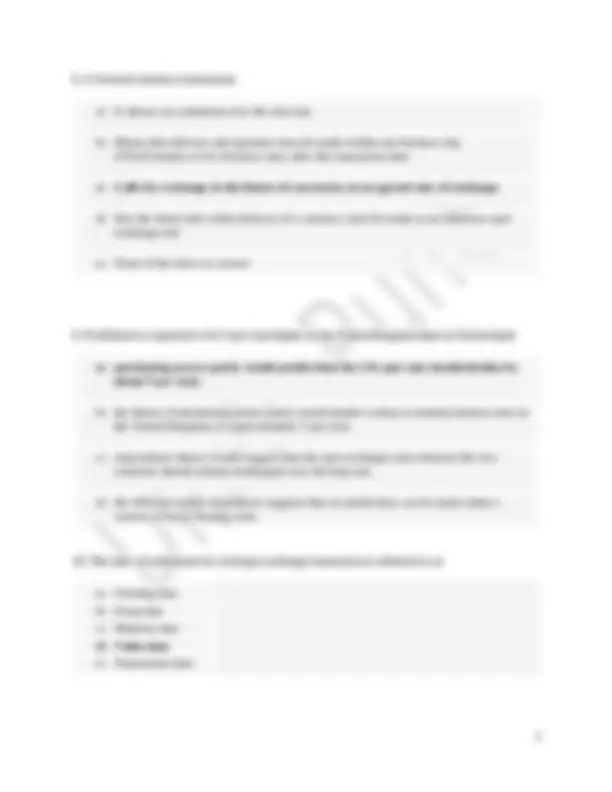
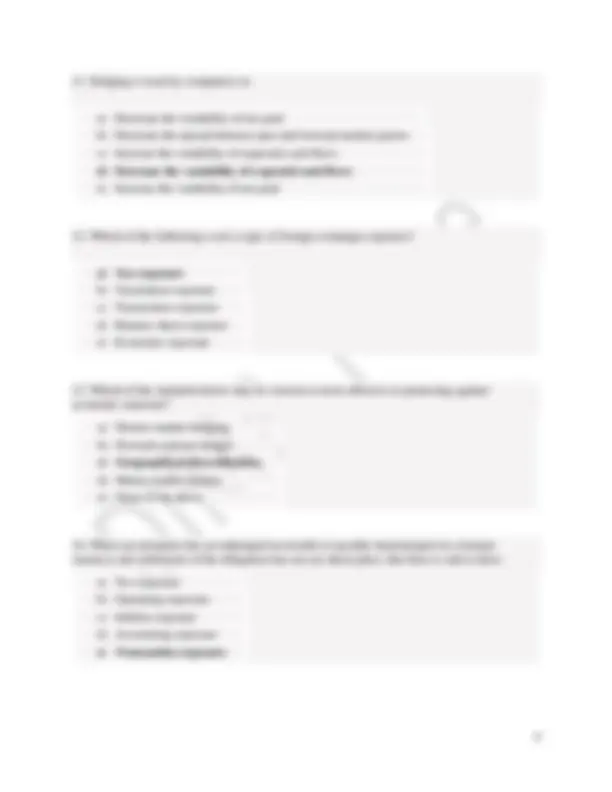
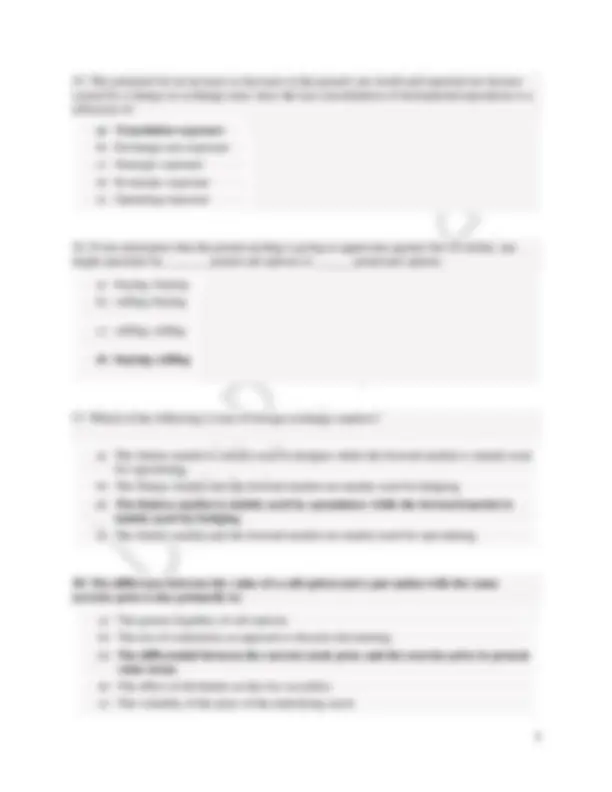
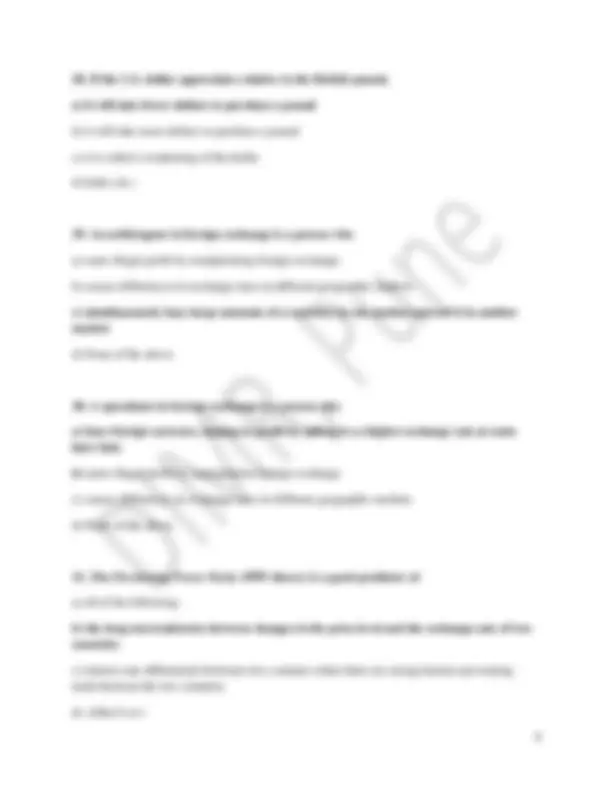
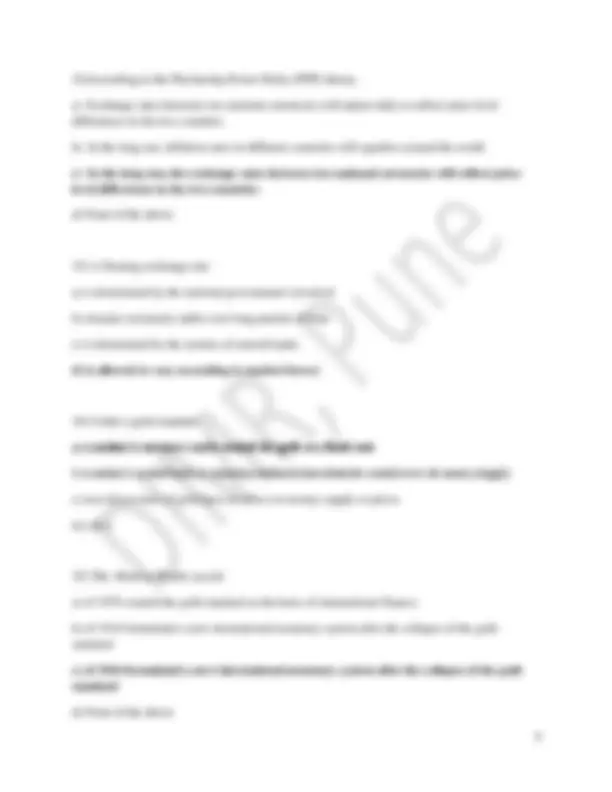
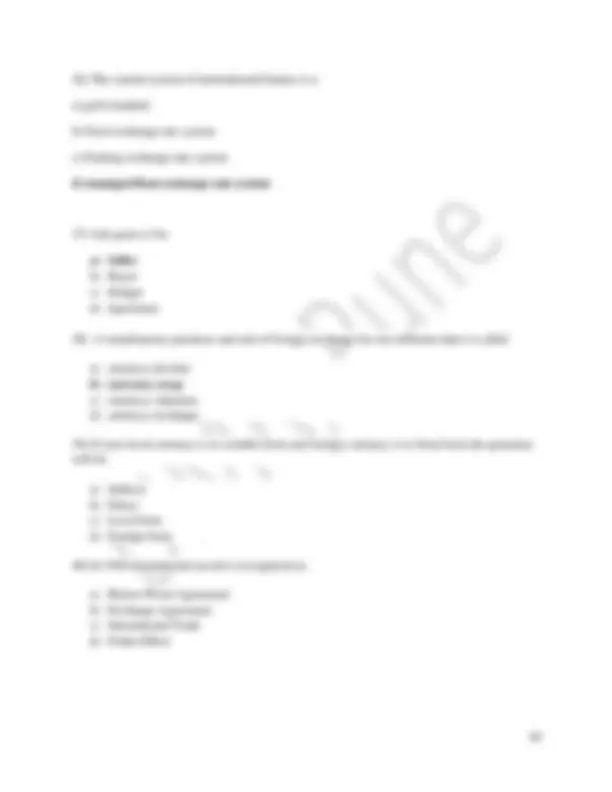



Study with the several resources on Docsity

Earn points by helping other students or get them with a premium plan


Prepare for your exams
Study with the several resources on Docsity

Earn points to download
Earn points by helping other students or get them with a premium plan
Community
Ask the community for help and clear up your study doubts
Discover the best universities in your country according to Docsity users
Free resources
Download our free guides on studying techniques, anxiety management strategies, and thesis advice from Docsity tutors
International finance MCQ questions for ICFAI
Typology: Exercises
1 / 13

This page cannot be seen from the preview
Don't miss anything!








a) The dollar exchanges for 1 pound and then exchanges for 1.2 pounds. b) The dollar exchanges for 250 yen and then exchanges for 275 francs. c) The dollar exchanges for 100 francs and then exchanges for 120 yen. d) The dollar exchanges for 120 francs and then exchanges for 100 francs
a) the value of all currencies fall relative to gold. b) the value of all currencies rise relative to gold. c) the value of one currency rises relative to another currency. d) the value of one currency falls relative to another currency.
a) the home currency will appreciate if the current home inflation rate exceeds the current foreign inflation rate; b) the home currency will depreciate if the current home interest rate exceeds the current foreign interest rate; c) the home currency will depreciate if the current home inflation rate exceeds the current foreign inflation rate. d) the home currency will depreciate if the current home inflation rate exceeds the current foreign interest rate;
a) real exchange rates should tend to decrease over time; b) quoted nominal exchange rates should be stable over time. c) real exchange rates should tend to increase over time; d) real exchange rates should be stable over time;
a) Interest rates should change by an equal amount but in the opposite direction to the difference in inflation rates between two countries
b) The difference in interest rates in different currencies for securities of similar risk and maturity should be consistent with the forward rate discount or premium for the foreign currency
c) The interest rates between two countries start in equilibrium, any change in the differential rate of inflation between the two countries tends to be offset over the long- term by an equal but opposite change in the spot exchange rate
d) In the long run real interest rate between two countries will be equal e) Nominal interest rates in each country are equal to the required real rate plus compensation for expected inflation
a) Decrease the variability of tax paid b) Decrease the spread between spot and forward market quotes c) Increase the variability of expected cash flows d) Decrease the variability of expected cash flows e) Increase the variability of tax paid
a) Tax exposure b) Translation exposure c) Transaction exposure d) Balance sheet exposure e) Economic exposure
a) Futures market hedging b) Forward contract hedges c) Geographical diversification d) Money market hedges e) None of the above
a) Tax exposure b) Operating exposure c) Infinite exposure d) Accounting exposure e) Transaction exposure
a) Translation exposure b) Exchange rate exposure c) Strategic exposure d) Economic exposure e) Operating exposure
a) buying; buying b) selling; buying
c) selling; selling
d) buying; selling
a) The futures market is mainly used by hedgers while the forward market is mainly used for speculating. b) The futures market and the forward market are mainly used for hedging. c) The futures market is mainly used by speculators while the forward market is mainly used for hedging. d) The futures market and the forward market are mainly used for speculating.
18. The difference between the value of a call option and a put option with the same exercise price is due primarily to:
a) The greater liquidity of call options b) The use of continuous as opposed to discrete discounting c) The differential between the current stock price and the exercise price in present value terms d) The effect of dividends on the two securities e) The volatility of the price of the underlying stock
a) By purchasing single forward contract b) By purchasing multiple forward contract c) Cannot be hedged by forward contracts d) None of the above
a) Efficient b) Perfect c) Imperfect d) Both a & b
a) total yearly amount of money changed from one country’s currency to another country’s currency
b) total monetary value of exports minus imports
c) amount of country’s currency which can exchanged for one ounce of gold
d) price of one country’s currency in terms of another country’s currency
27. Exchange rates
a) are always fixed
b) fluctuate to equate the quantity of foreign exchange demanded with the quantity supplied
c) fluctuate to equate imports and exports
d) fluctuate to equate rates of interest in various countries
28. If the U.S. dollar appreciates relative to the British pound,
a) it will take fewer dollars to purchase a pound
b) it will take more dollars to purchase a pound
c) it is called a weakening of the dollar
d) both a & c
29. An arbitrageur in foreign exchange is a person who
a) earns illegal profit by manipulating foreign exchange
b) causes differences in exchange rates in different geographic markets
c) simultaneously buys large amounts of a currency in one market and sell it in another market
d) None of the above
30. A speculator in foreign exchange is a person who
a) buys foreign currency, hoping to profit by selling it a a higher exchange rate at some later date
b) earns illegal profit by manipulation foreign exchange
c) causes differences in exchange rates in different geographic markets
d) None of the above
31. The Purchasing Power Parity (PPP) theory is a good predictor of
a) all of the following:
b) the long-run tendencies between changes in the price level and the exchange rate of two countries
c) interest rate differentials between two countries when there are strong barriers preventing trade between the two countries
d) either b or c
a) gold standard
b) fixed exchange rate system
c) floating exchange rate system
d) managed float exchange rate system
37 ) Ask quote is for
a) Seller b) Buyer c) Hedger d) Speculator
38 ) A simultaneous purchase and sale of foreign exchange for two different dates is called
a) currency devalue b) currency swap c) currency valuation d) currency exchange
39 ) If your local currency is in variable form and foreign currency is in fixed form the quotation will be:
a) Indirect b) Direct c) Local form d) Foreign form
40 ) In 1944 international accord is recognized as
a) Breton Wood Agreement b) Exchange Agreement c) International Trade d) Fisher Effect
41 ) In a quote exchange rate, the currency that is to be purchase with another currency is called the
a) liquid currency b) foreign currency c) local currency d) base currency
42 ) An economist will define the exchange rate between two currencies as the:
a) Amount of one currency that must be paid in order to obtain one unit of another currency b) Difference between total exports and total imports within a country c) Price at which the sales and purchases of foreign goods takes place d) Ratio of import prices to export prices for a particular country
43 ) The Purchasing Power Parity should hold:
a) Under a fixed exchange rate regime b) Under a flexible exchange rate regime c) Under a dirty exchange rate regime d) Always
44 ) Which of the following is NOT a criticism of a flexible exchange rate system?
a) Flexible exchange rates tend to be variable and therefore cause more uncertainty b) Flexible exchange rate systems require discipline on the part of central banks that may not be forthcoming c) Under flexible exchange rates, trading countries tend to rely more heavily upon tariffs and other restrictions d) The flexible exchange rate system reduces the power of fiscal policy
45 ) Arbitrageurs in foreign exchange markets:
a) attempt to make profits by outguessing the market) b) make their profits through the spread between bid and offer rates of exchange) c) take advantage of the small inconsistencies that develop between markets) d) need foreign exchange in order to buy foreign goods)